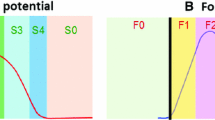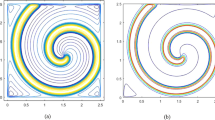Abstract
Cardiac electrophysiological simulation is a very complex computational process, which can be run on graphics processing unit (GPU) to save computational cost greatly. The use of adaptive time-step can further effectively speed up the simulation of heart cells. However, if the adaptive time-step method applies to GPU, it suffers synchronization problem on GPU, weakening the acceleration of adaptive time-step method. The previous work ran on a single GPU with the adaptive time-step to get only 1.5 times (× 1.5) faster than the fixed time-step. This study proposes a memory allocation method, which can effectively implement the adaptive time-step method on GPU. The proposed method mainly focuses on the stimulus point and potential memory arrangement in order to achieve optimal memory storage efficiency. All calculation is implemented on GPU. Large matrices such as potential are arranged in column order, and the cells on the left are stimulated. The Luo-Rudy passive (LR1) and dynamic (LRd) ventricular action potential models are used with adaptive time-step methods, such as the traditional hybrid method (THM) and Chen-Chen-Luo’s (CCL) “quadratic adaptive algorithm” method. As LR1 is solved by the THM or CCL on a single GPU, the acceleration is × 34 and × 75 respectively compared with the fixed time-step. With 2 or 4 GPUs, the acceleration of the THM and CCL is × 34 or × 35 and × 73 or × 75, but it would decrease to × 5 or × 3 and × 20 or × 15 without optimization. In an LRd model, the acceleration reaches × 27 or × 85 as solved by the THM or CCL compared with the fixed time-step on multi-GPU with linear speed up increase versus the number of GPU. However, with the increase of GPUs number, the acceleration of the THM and CCL is continuously weakened before optimization. The mixed root mean square error (MRMSE) lower than 5% is applied to ensure the accuracy of simulation. The result shows that the proposed memory arrangement method can save computational cost a lot to speed up the heart simulation greatly.

Acceleration ratio compared with CPU with fixed time-step (dt = 0.001 ms).










Similar content being viewed by others
References
Rocha BM, Campos FO, Amorim RM, Plank G, Santos RW, Liebmann M, Haase G (2011) Accelerating cardiac excitation spread simulations using graphics processing units. Concurr Comput-Pract Experience 23(7):708–720
Vigueras G, Roy I, Cookson A, Lee J, Smith N, Nordsletten D (2014) Toward GPGPU accelerated human electromechanical cardiac simulations. Int J Numer Methods Biomed Eng 30:117–134
Wang W, Xu L, Cavazos J et al (2014) Fast acceleration of 2D wave propagation simulations using modern computational accelerators. PLoS One 9:e86484
Chai J, Wen M, Wu N et al (2013) Simulating cardiac electrophysiology in the era of GPU-cluster computing. IEICE Trans Inf Syst 12:2587–2595
Neic A, Liebmann M, Hoetzl E, Mitchell L, Vigmond EJ, Haase G, Plank G (2012) Accelerating cardiac Bidomain simulations using graphics processing units. IEEE Trans Biomed Eng 59:2281–2290
Nimmagadda VK, Akoglu A, Hariri S et al (2012) Cardiac simulation on multi-GPU platform. J Supercomput 59:1360–1378
Esmaili E, Akoglu A, Hariri S et al (2019) Implementation of scalable bidomain-based 3D cardiac simulations on a graphics processing unit cluster. J Supercomput 75 : 5475–5506.
Xia Y, Wang K, Zhang H (2015) Parallel optimization of 3D cardiac electrophysiological model using GPU. Computational and Mathematical Methods in Medicine, 4:862735
Amorim R, Haase G, Liebmann M et al. (2009) Comparing CUDA and OpenGL implementations for a Jacobi iteration. In: HPCS’09. International Conference on High Performance Computing & Simulation, IEEE, 22–32
Victor M, Liberos Garcia A, Climent AM et al. (2011) An adaptive step size GPU ODE solver for simulating the electric cardiac activity. Computing in Cardiology, Hangzhou. 233-236
Garcia-Molla VM, Liberos A, Vidal A, Guillem MS, Millet J, Gonzalez A, Martinez-Zaldivar FJ, Climent AM (2014) Adaptive step ODE algorithms for the 3D simulation of electric heart activity with graphics processing units. Comput Biol Med 44:15–26
Oliveira RS, Rocha BM, Burgarelli D et al (2018) Performance evaluation of GPU parallelization, space-time adaptive algorithms, and their combination for simulating cardiac electrophysiology. Int J Numer Methods Biomed Eng 34:e2913
Rush S, Larsen H (1978) A practical algorithm for solving dynamic membrane equations. IEEE Trans Biomed Eng 25:389–392
Luo CH, Rudy Y (1991) A model of the ventricular cardiac action potential. Depolarization, repolarization, and their interaction. Circ Res 68:1501–1526
Beeler GW, Reuter H (1977) Reconstruction of the action potential of ventricular myocardial fibres. J Physiol 268:117–210
Luo CH, Rudy Y (1994) A dynamic model of the cardiac ventricular action potential II Afterdepolarizations, triggered activity, and potentiation. Circ Res 74:1097–1113
Chen X-J, Luo C-H, Chen M-H, Zhou X (2019) Combination of “quadratic adaptive algorithm” and “hybrid operator splitting” or uniformization algorithms for stability against acceleration in the Markov model of sodium ion channels in the ventricular cell model. Med Biol Eng Comput 57:1367–1379
Victorri B, Vinet A, Fernand A et al (1985) Numerical integration in the reconstruction of cardiac action potentials using Hodgkin-Huxley-type models. Comput Biomed Res 18:10–23
Chen M-H, Chen P-Y, Luo C-H (2016) Quadratic adaptive algorithm for solving cardiac action potential models. Comput Biol Med 77:261–273
Green KR, Spiteri RJ (2019) Gating-enhanced IMEX splitting methods for cardiac monodomain simulation. Numerical Algorithms 81: 1443–1457
Funding
This work was supported by Sun Yat-sen University, China, under Scientific Initiation Project (No.67000–18821109) for high-level experts.
Author information
Authors and Affiliations
Corresponding author
Ethics declarations
Conflict of interest
The authors declare that they have no conflict of interest.
Additional information
Publisher’s note
Springer Nature remains neutral with regard to jurisdictional claims in published maps and institutional affiliations.
Rights and permissions
About this article
Cite this article
Luo, CH., Ye, H. & Chen, X. A memory optimization method combined with adaptive time-step method for cardiac cell simulation based on multi-GPU. Med Biol Eng Comput 58, 2821–2833 (2020). https://doi.org/10.1007/s11517-020-02255-0
Received:
Accepted:
Published:
Issue Date:
DOI: https://doi.org/10.1007/s11517-020-02255-0




